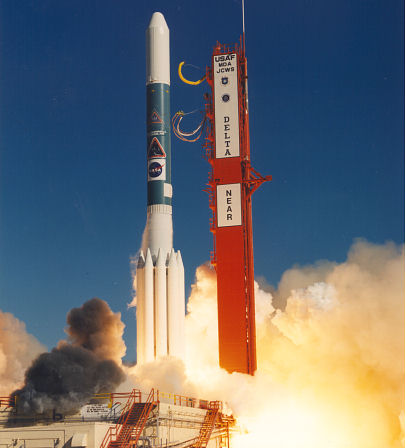DELTA II 7000 SERIES FACT SHEET
By Cliff Lethbridge

Delta II 7000 Series Launch, Photo Courtesy NASA
Classification: Space Launch Vehicle
Length: 128 feet
Diameter: 8 feet
Date of First Cape Canaveral Launch: November 26, 1990
Date of Final Cape Canaveral Launch: September 10, 2011
Number of Cape Canaveral Launches: 94
The Delta II 7000 Series improved performance by employing new solid rocket boosters. Lightweight Hercules (later Alliant Techsystems) Graphite Epoxy solid rocket boosters, larger and more powerful than previously employed Castor solid rocket boosters, improved the overall vehicle thrust. The solid rocket boosters were called Graphite Epoxy Motors (GEM). Each GEM was 42 feet, 6 inches long and had a diameter of 3 feet, 4 inches. Each GEM burned HTPB solid fuel. The GEM’s ignited on the ground, or “ground-lit” GEM’s, could each produce a thrust of about 112,200 pounds. The GEM’s ignited in the air, or “air-lit” GEM’s, could each produce a thrust of about 116,100 pounds. A Rocketdyne first stage engine could produce a liftoff thrust of about 200,000 pounds. Like previous Delta variants, the first stage burned a combination of liquid oxygen and RP-1 (kerosene) liquid fuel. An Aerojet second stage engine burned a combination of nitrogen tetroxide and Aerozine-50 liquid fuel. The second stage engine could produce a thrust of about 9,815 pounds. Several Delta II 7000 Series rockets were available with two stages only, and were used for carrying payloads into low-Earth orbit.
Payload capability of the two-stage variants depended on the number of GEM’s employed and the size of the payload fairing, which was offered in diameters of 9 feet, 6 inches or 10 feet. The heaviest payloads could be carried using the smaller, lighter payload fairing. The Delta II 7320 employed three GEM’s and with the 9-foot, 6-inch diameter payload fairing could carry a maximum 6,320-pound payload to low-Earth orbit. The Delta II 7420 employed four GEM’s and with the 9-foot, 6-inch diameter payload fairing could carry a maximum 6,970-pound payload to low-Earth orbit. The most powerful of the two-stage Delta II 7000 Series rockets, designated Delta II 7920, employed nine GEM’s and could carry an 11,330-pound payload to low-Earth orbit using the 9-foot, 6-inch payload fairing. A number of three-stage versions of the Delta II 7000 series were available to meet diverse mission applications. All of the three-stage variants employed a Thiokol solid-fueled third stage that could produce a thrust of about 14,920 pounds.
As with the two-stage variants, performance of the three-stage Delta II 7000 Series rockets depended upon the number of GEM’s employed and the size of the payload fairing, which was offered in diameters of 9 feet, 6 inches or 10 feet. The heaviest payloads could be carried employing the smaller, lighter payload fairing. The Delta II 7325 employed three GEM’s, and with the 9-foot, 6-inch diameter payload fairing could carry a maximum 2,210-pound payload to geostationary transfer orbit or a maximum 1,615-pound payload to Earth-escape trajectory. The Delta II 7425 employed four GEM’s, and with the 9-foot, 6-inch diameter payload fairing could carry a maximum 2,490-pound payload to geostationary transfer orbit or a maximum 1,770-pound payload to Earth-escape trajectory. The Delta II 7925 employed nine GEM’s, and with the 9-foot, 6-inch diameter payload fairing could carry a maximum 4,120-pound payload to geostationary transfer orbit or a maximum 2,900-pound payload to Earth-escape trajectory.


